- Home
- Cassandra Clare
Shadowhunter’s Codex Page 9
Shadowhunter’s Codex Read online
Page 9
* * *
TREATING VAMPIRE BITES
Important! Note!
Why’s it gotta be like that, man?
If a vampire bites and drinks blood from a victim, no supernatural treatment may be needed. Normal Shadowhunter wound-care protocols apply—the use of an iratze or other healing Marks, and treatment for blood loss and shock if the draining has been severe. Mundanes also can have their blood taken by vampires with no permanent ill effects, provided the wounds are cared for and not too much blood has been taken.
The real danger lies in the case of a human who has consumed vampire blood. Even if not enough blood is consumed to cause the death and rebirth of the victim as a vampire, the smallest amount of vampire blood is enough to create in the victim an irresistible pull to vampires, which could cause that victim to become a subjugate, begging to be Turned.
The proper treatment for the consumption of vampire blood is emetic: The victim must be made to drink holy water until all of the vampire blood is out of his system. The victim is likely to be very sick during this process—he will of course cough up everything in his system, not just the vampire blood, and the presence of the blood is likely to have made him fevered and hot to the touch. This process is, however, much better than the alternative.
Even a small amount of vampire blood consumed may require the consumption of quite a lot of holy water. This is a case where it is better to be safe and consume too much holy water than too little. The victim can be assumed to be healthy and cured when the consumption of holy water no longer produces the emetic response.
SUBJUGATES
Powerful vampires will often decide that, rather than feeding haphazardly on whatever blood they can find, they would prefer a ready supply. They will then create a vampire subjugate: They will select a victim and keep him close by, drinking from him and also feeding him small amounts of vampire blood. This vampire blood will make the subjugate docile, obedient, and, in time, worshipful of his vampire master. The subjugate will cease eating food and will survive entirely on a mix of animal blood and vampire blood. He will not become a full vampire, but subjugates are kept in a suspended animation, their aging process drastically slowed (although they are not immortal and will eventually die).
A subjugate who is turned into a vampire loses his obedient and worshipful nature and becomes a normal vampire, like any other.
Most subjugates are young in appearance; vampires revere youth and beauty and tend to prefer their subjugates to possess both. (A practical consideration is also present. The younger the subjugate, the less chance that he will turn out to have diseased or otherwise problematic blood.)
Subjugates are sometimes known as darklings. Although the term is archaic, it is still used in some formal vampire rituals today. Vampires love nothing so much as formal rituals.
The culture of subjugates among vampires is that, first, they are no longer human but are something else, and therefore are not afforded the rights and respect granted to humans. Subjugation is in essence voluntary slavery; subjugates effectively consent to become the property of their vampire masters, renounce their human names, and so on. A subjugate would never introduce himself to another vampire or another subjugate, for instance; it would be his master’s choice whether to communicate his name, or indeed, whether the subjugate would possess an identifying name at all.
The creation of new subjugates was made illegal in the Seventh Accords of 1962. Vampires who had subjugates created prior to the Accords were allowed to keep them. The Law also continues to allow vampires to transfer existing subjugates to other vampires. These two facts have made it almost impossible to convict vampires for creating subjugates. Vampires simply claim that their subjugates predate the Accords, and since the subjugates’ identities and lives are tracked by the vampires themselves, it is very hard to prove otherwise.
FLEDGLINGS
Note: did not read. Too soon.
A human who has consumed enough vampire blood to be themselves transformed into a vampire does not, as some popular mundane stories would have it, abruptly turn from a living human in one moment to a vampire in the next. The human—who is known in vampire culture as a “fledgling”—must die, be buried, and, in being reborn, make his way out of his grave of his own power. (In the rare and sad case that a Shadowhunter is irreversibly turned into a vampire, this is the one circumstance in which her body may be buried rather than burned.)
Like a ghost, a fledgling rising from his grave draws energy and strength from the living things nearby, drawing their heat and producing a distinctive cold spot around his grave. When he has risen, he will be nearly feral and starving for the blood that will, for eternity, sustain him. This is why fledglings are the most dangerous of vampires. Sometimes a vampire clan will turn a human to a vampire purposefully, and in those cases the transition usually goes smoothly. The clan can be present for the vampire’s rising, can make sure he is able to successfully rise, and can supply him with blood and take him to a safe place to recover. This is, however, not the way that most vampires are made; most are made by accident. In those cases the fledgling is buried by his friends and family, as any other mundane would be, and rises unexpectedly, in a mundane location, desperate for blood and barely knowing himself. These are the circumstances that lead to vampire attacks and the deaths of mundanes. While such an out-of-control fledgling must be stopped, it is not the policy of the Shadowhunters to consider these fledglings rogue vampires, and thus the fledglings should be turned over either to a local vampire clan or, preferably, to the Praetor Lupus, both of which are well-equipped to take care of the fledgling’s needs.
WARLOCKS
Perhaps no other Downworlders have a more complex relationship with Shadowhunters than do warlocks. The offspring of demons and mundanes, warlocks do not have the many unifying features of werewolves or vampires, or even of faeries. The only things that can be said to be true of all warlocks are that (1) they possess a so-called warlock mark on their body that identifies them as not merely human, (2) like most hybrid species they are sterile, and (3) they possess the ability to perform magic. It is this last feature that makes them at once the most powerful of Downworlders and the most closely tied to Shadowhunters. For the whole of our history we have worked in concert with warlocks, whether as partners or (more commonly) as hired specialists, to allow us to make use of some of the demonic magic that our own powers exclude us from.
Needless to say, warlocks are rarely born from an affectionate relationship between a demon and a human. Instead they are created through one of the two worst depredations demons visit upon our world. Most obviously, there are warlocks born from demons violating humans against their will. This was the predominant means of warlock conception in the time before the Incursion, when demons were rare and normally appeared in isolation. Today, though, demons are much less likely to manifest themselves openly, since the presence of Shadowhunters and the much larger number of Downworlders makes them more likely to be discovered and attacked. Therefore, today most warlocks are the result of a different kind of violation: the coupling of a human with an Eidolon demon (see “Demonologie,” Chapter 3) who is disguised as the human’s loved one.
Warlocks cannot be produced from the union of a demon and a Shadowhunter; because the angelic Shadowhunter blood and the demonic blood both normally dominate, the combination cannot create a living child. The offspring of a Shadowhunter and a demon is death.
IF YOU MEET A WARLOCK
Nothing can be generally said to be true of meetings with warlocks; these Downworlders vary in temperament and quality as much as humans as a whole. It is only noted here that it is considered impolite to stare at a warlock’s mark.
WARLOCKS AND MAGIC
All warlocks are to some extent practitioners of magic. Some inherit more magical aptitude than others, and those who cultivate that aptitude may become quite powerful among warlocks and quite useful to the Nephilim. The most gifted may find themselves able to study demonic
magic in the secretive Spiral Labyrinth, the central home of warlock magical research and knowledge. Unlike Nephilim, warlocks do inherently possess magic. They have invented quite a lot of new magic, in fact, which is dutifully recorded and kept in the Labyrinth. The location of the Labyrinth is unknown even to the Nephilim, and possibly it exists in its own pocket dimension separate from our world. Its age is also unknown. According to our earliest Nephilimic writings, it was already considered ancient in the time of Elphas the Unsteady (see Excerpts from A History of the Nephilim, Appendix A). The magic by which one may travel there is one of the most closely guarded secrets in all the world, and it’s whispered that a geas placed on all warlocks at the moment of their birth guarantees that if a warlock reveals the Labyrinth’s location to a non-warlock, the result would be instant and blindingly painful death. It is also whispered that this is completely bogus.
The warlocks have in some ways suffered more than any other Downworlders; they have neither the clan communities of werewolves and vampires nor the sacred home of the fey, and have had to make their way in our world largely by their own individual courage and cunning. The Nephilim have not always provided a safe haven for warlocks—for example, turning on them and slaughtering them by the hundreds in the time of the Schism (see Appendix A). Today we can only mourn the loss of trust and cooperation that once existed between warlocks and Shadowhunters. Relations between the two have improved greatly since the Accords, which guarantee not only the rights of warlocks but legal permission for them to perform demonic magic when acting to assist a Nephilim investigation. It is likely, though, that the kind of mutual assistance, angelic and demonic together in the form of Nephilim and warlocks, that marked the great flourishing of magic in the Middle Ages will never again be seen. Too bad about all that slaughtering, Clave. Not exactly making me swell with pride about my people here.
WARLOCK MARKS
Every warlock has some feature on his body that labels him as not fully human. These marks (not to be confused with the Marks of Raziel that we use) are as varied as demonkind and range from the subtle to the glaringly obvious. A warlock’s fate among the mundanes may well be decided not by himself or by his origins but by whether he is marked with, for example, strangely colored eyes or unusual height, or with blue skin or ram’s horns or tiger stripes or a shiny black carapace. Any unusual feature can of course be glamoured into invisibility, but the warlock mark is present from birth, and recall that most mundanes are unaware of anything strange about their child until he is born and his mark is revealed. Even among those parents fully aware of the partially demonic parentage of their child, a warlock mark may be a deeply unpleasant surprise. These marks seem unrelated to the particular type of demon parent; it is not so much the inheritance of a demonic feature as the arbitrary mutation of the body in response to demonic magic coursing through it. Note: Magnus’s eyes.
Hey baby, guess where my warlock mark is.
Never works. Trust me. Never works.
* * *
IFRITS
Rarely, but sometimes, a warlock is born who, though the child of a demon and a human, has no access to demonic magic. These unfortunate souls have the disadvantages of a warlock—the warlock aspect that marks them as not fully human—but cannot perform magic. These so-called ifrits are trapped on the limens of the magical world, suffering the stigma of their inhuman marks without the benefit of supernatural power. Historically they have fallen into the underclass of the supernatural world, and are often found working on the wrong side of the Law, unable to live in the mundane world but unable to find a respectable life in the Shadow World.
Sometimes, of course, an ifrit is born with a warlock mark that can be easily hidden from public view. These “ghost ifrits” can sometimes make their way through mundane human society without complication, and as such may have no doings with the Shadow World at all. Today most ifrits with marks that are difficult to disguise acquire magical artifacts that provide them with a permanent glamour and live away from the magical world, unable to have children of their own but otherwise unremarkable to mundanes.
FAERIES
Note: The Fair Folk are not actually fair. They are big cheaters in fact.
Strange they may be, alien to us, more unknown than demons themselves, but the fey, the faeries, are Downworlders. They are people—they have souls. They are the least understood of all magical peoples, the great ancient mystery of our world. They are found in countless varieties, sizes, and types, and in all environments.
Most properly these creatures are known as “faeries,” after their homeland, the realm of Faerie. They are known in literature by many other names, partly because of their enormous variety and partly because of age-old superstitions about invoking them by name. Most commonly they are called the fey, but you will also hear them named the Fair Folk, or the Kind Ones, or the Little People, or any number of other euphemisms.
IF YOU MEET A FAERIE
Do not sign any contracts or agree to any bargains with faeries. Faeries love to haggle but will usually do so only if they are sure they will win. Do not eat or drink anything a faerie gives you. Do not go attend their magical revels under the hills. They will paint a beautiful picture of what awaits you there, but its beauty is false and hollow. Do not tease a faerie about their height. Do not expect direct answers to direct questions. Do expect indirect answers to indirect questions.
Faeries will always exactly follow the letter of any promise they have made, but expect results delivered with great irony.
Many Shadowhunters have been taken in, despite these rules, by a belief that the particular faerie they met was simpleminded, naive, generous, and so on. This playacting is yet another ploy.
This is a little harsh. Faeries not that bad.
I don’t think I agree!
WHERE DO FAERIES COME FROM?
The fey are originally the offspring of demons and angels, with the beauty of angels and the viciousness of demons. (Obviously, since angels are rarely if ever seen in our world in current times, the vast majority of faeries are the offspring of other faeries, just as most Shadowhunters are the offspring of other Shadowhunters and not born from the Cup.) The Fair Folk cannot be said to be morally aligned with either of their parent races. They are good and evil tangled up, following neither the morality of Heaven nor the immorality of Hell but rather their own capricious code of behavior. They are known for their cunning and their cruel sense of humor, and they delight especially in tricking humans—mundanes and Shadowhunters alike. They frequently seek to bargain with humans, offering someone his heart’s desire but failing to mention that that desire comes with a terrible cost. They are very long-lived and become only more artful and powerful as they age.
They are the other Downworlders, along with werewolves, who can bear children. They can also have offspring with humans. These offspring will be human and not fey, but they often retain some faerielike aspects or have a penchant for certain kinds of fey magic. It’s widely believed, for instance, that humans who naturally possess the Sight have inherited it from some faerie ancestor.
As with werewolves, the children of faeries and Shadowhunters will be Shadowhunters.
Although the fey are active members of Downworld, and signers of the Accords, faeries are more removed from the affairs of our world than any other known creatures except angels. They usually keep to themselves, and have their own complex politics and social structures, which only tangentially affect our world. Commonly they are organized into courts, with sovereigns presiding over specific territories in our world and in theirs. However, there are just as many, if not more, free-ranging faeries in the world unaffiliated with any specific monarch. Just as the fey delight in manipulating humans, they delight in manipulating one another, and usually if the problems of the fey intrude into our world, it is the result of conflicts between rival courts, sometimes playful, sometimes serious and brutal.
FEY AND MAGIC
The magic of the fey is, as far as
we know, unique in the world. It is very powerful but neither demonically nor seraphically allied, and it cannot be learned or wielded by any creatures other than the fey themselves. This magic is slippery and chaotic and is not easily given to structure and rules that can be learned. Nephilim Marks exist that can protect you from faerie glamours, but you should never, ever allow yourself to feel safe or at ease in the presence of faeries. Believing yourself to have the upper hand in a negotiation with a faerie is a sure sign that you are being deceived and will suffer for it in the end.
Why, then, if they are so removed from our world, do the fey continue to interact with humans as much as they do? The answer lies in genetics.
The biggest problem facing the fey in our modern world is the thinning of their blood. Over time the problem of extensive interbreeding leads to the weakening of family lines. For this reason faeries spend much of their time luring humans into their world. They pursue this in two ways: by creating changelings (see below) and by enticing adult humans into their revels. Much faerie magic exists to trap these reveling humans in Faerie forever, or at least for a long enough time that either they “go native” and forget their former lives or they can be used to produce new faerie children.
There are ways for mundanes (and Shadowhunters) to successfully join the faerie revels without trapping themselves in Faerie. A faerie could be convinced (or bargained with) to give a human a token of safe passage—usually something like a leaf or a flower. And a faerie who voluntarily brings a specific human to the revels can offer his protection and guarantee the human’s ability to leave. These bargains, however, are subject to the usual faerie trickery and duplicity, and mundanes and Shadowhunters alike should beware.

 The Midnight Heir
The Midnight Heir Son of the Dawn
Son of the Dawn Angels Twice Descending
Angels Twice Descending City of Bones
City of Bones Vampires, Scones, and Edmund Herondale
Vampires, Scones, and Edmund Herondale Bitter of Tongue
Bitter of Tongue What Really Happened in Peru
What Really Happened in Peru Shadowhunters and Downworlders
Shadowhunters and Downworlders Learn About Loss
Learn About Loss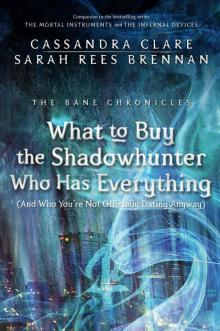 What to Buy the Shadowhunter Who Has Everything
What to Buy the Shadowhunter Who Has Everything Welcome to Shadowhunter Academy
Welcome to Shadowhunter Academy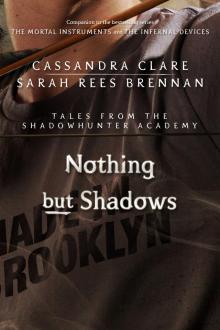 Nothing but Shadows
Nothing but Shadows Clockwork Prince
Clockwork Prince The Fiery Trial
The Fiery Trial City of Glass
City of Glass Clockwork Angel
Clockwork Angel City of Heavenly Fire
City of Heavenly Fire The Rise of the Hotel Dumort
The Rise of the Hotel Dumort The Shadowhunters Codex
The Shadowhunters Codex Cast Long Shadows
Cast Long Shadows City of Lost Souls
City of Lost Souls Lady Midnight
Lady Midnight Lord of Shadows
Lord of Shadows The Whitechapel Fiend
The Whitechapel Fiend City of Fallen Angels
City of Fallen Angels Clockwork Princess
Clockwork Princess Queen of Air and Darkness
Queen of Air and Darkness Saving Raphael Santiago
Saving Raphael Santiago The Red Scrolls of Magic
The Red Scrolls of Magic City of Ashes
City of Ashes Pale Kings and Princes
Pale Kings and Princes The Runaway Queen
The Runaway Queen The Last Stand of the New York Institute
The Last Stand of the New York Institute A Long Conversation (The Shadowhunter Chronicles)
A Long Conversation (The Shadowhunter Chronicles) The Lost Book of the White
The Lost Book of the White Chain of Gold
Chain of Gold The Fall of the Hotel Dumort
The Fall of the Hotel Dumort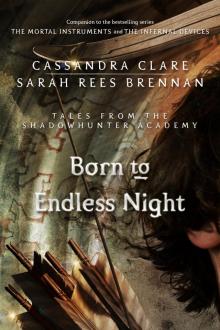 Born to Endless Night
Born to Endless Night The Lost Herondale
The Lost Herondale An Illustrated History of Notable Shadowhunters & Denizens of Downworld
An Illustrated History of Notable Shadowhunters & Denizens of Downworld Ghosts of the Shadow Market
Ghosts of the Shadow Market Through Blood, Through Fire
Through Blood, Through Fire Every Exquisite Thing
Every Exquisite Thing City of Fallen Angels mi-4
City of Fallen Angels mi-4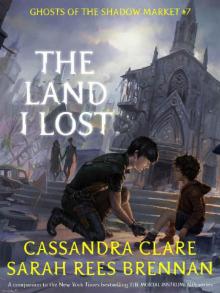 The Land I Lost (Ghosts of the Shadow Market Book 7)
The Land I Lost (Ghosts of the Shadow Market Book 7) Queen of Air and Darkness (The Dark Artifices #3)
Queen of Air and Darkness (The Dark Artifices #3) The Wicked Ones (Ghosts of the Shadow Market Book 6)
The Wicked Ones (Ghosts of the Shadow Market Book 6) The Wicked Ones
The Wicked Ones A Deeper Love
A Deeper Love City of Fallen Angels (4)
City of Fallen Angels (4) The Evil We Love (Tales from the Shadowhunter Academy Book 5)
The Evil We Love (Tales from the Shadowhunter Academy Book 5) Vampires, Scones, and Edmund Herondale tbc-3
Vampires, Scones, and Edmund Herondale tbc-3 City of Glass mi-3
City of Glass mi-3 Tales from the Shadowhunter Academy
Tales from the Shadowhunter Academy The Infernal Devices Series
The Infernal Devices Series City of Ashes mi-2
City of Ashes mi-2 Cassandra Clare: The Mortal Instruments Series
Cassandra Clare: The Mortal Instruments Series The Bane Chronicles 7: The Fall of the Hotel Dumort
The Bane Chronicles 7: The Fall of the Hotel Dumort The Last Stand of the New York Institute (The Bane Chronicles)
The Last Stand of the New York Institute (The Bane Chronicles) The Land I Lost
The Land I Lost![Saving Raphael Santiago - [Bane Chronicles 06] Read online](http://i1.bookreadfree.com/i1/04/03/saving_raphael_santiago_-_bane_chronicles_06_preview.jpg) Saving Raphael Santiago - [Bane Chronicles 06]
Saving Raphael Santiago - [Bane Chronicles 06] Clockwork Angel tid-1
Clockwork Angel tid-1 The Runaway Queen tbc-2
The Runaway Queen tbc-2 The Bane Chronicles
The Bane Chronicles City of Lost Souls mi-5
City of Lost Souls mi-5 Every Exquisite Thing (Ghosts of the Shadow Market Book 3)
Every Exquisite Thing (Ghosts of the Shadow Market Book 3) Shadowhunter’s Codex
Shadowhunter’s Codex Learn About Loss (Ghosts of the Shadow Market Book 4)
Learn About Loss (Ghosts of the Shadow Market Book 4)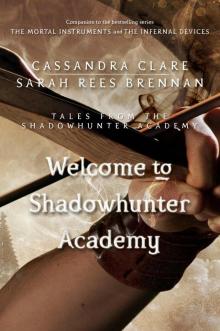 Welcome to Shadowhunter Academy (Tales from the Shadowhunter Academy Book 1)
Welcome to Shadowhunter Academy (Tales from the Shadowhunter Academy Book 1) Saving Raphael Santiago tbc-6
Saving Raphael Santiago tbc-6 City of Bones mi-1
City of Bones mi-1 Ghosts of the Shadow Market Book 1_Son of the Dawn
Ghosts of the Shadow Market Book 1_Son of the Dawn Clockwork Princess (Infernal Devices, The)
Clockwork Princess (Infernal Devices, The) Clockwork Prince tid-2
Clockwork Prince tid-2 No Immortal Can Keep a Secret
No Immortal Can Keep a Secret A Deeper Love (Ghosts of the Shadow Market Book 5)
A Deeper Love (Ghosts of the Shadow Market Book 5) The Course of True Love (and First Dates)
The Course of True Love (and First Dates)